“A small army of Ka’apor warriors marched into the depths of the Amazon forest in northeast Maranhao state, with me in tow. This was one day of a weeklong operation to protect and survey the Alto Turiacu Indian reserve, which has been invaded by illegal loggers for years. Ka’apor leader Irakadju told me how they had sought help from the Brazilian Army when they were in the region last year, but they had left, unwilling to ruin their jeeps and possibly afraid of the loggers. “We got tired of waiting for the government”, Irakadju said, while pushing through vines, branches and thorns. This feeling is shared by other Indians in different parts of the country. Last January the Munduruku Indians told me the exact same words as I hiked with them in search of wildcat miners. In July uncontacted Indians voluntarily emerged from the jungle, telling stories of violence committed against them by loggers along the border with Peru. The forest isn’t the only victim of the uncontrolled exploitation of natural resources in the Amazon. It also affects those whose centuries-old way of life depends on the forest.
The Ka’apor told me how loggers invaded the village of Gurupi last November, beat up their elders, shot animals and scared their children. In February, loggers shot at three warriors during an operation, and one injured Indian almost died. In May, federal prosecutors reported a “situation of conflict involving Ka’apor Indians and illegal exploiters of the forest” to the Federal Police, the environmental protection agency (Ibama), and the Indian affairs agency (Funai) and asked these agencies to take urgent measures within ten days. But nothing was done. With no government protection, the Ka’apor took matters into their own hands and started expelling the loggers. Ka’apor chiefs set up a meeting with the most experienced warriors from other villages to plan an operation.
The meeting lasted all night and afterwards the group set out and expelled a dozen loggers they found invading their territory. The warriors stripped them, tied them up and beat those who resisted. Before releasing them, one of the warriors told the loggers on the ground: “We’re doing this because you are stubborn. We told you not to come back, but you didn’t listen”. They then set fire to five trucks and three tractors equipped to pull down trees and transport them from the jungle. They confiscated chainsaws and shotguns that they carried back to the village saying: “Jande pairata” or “We are strong”. It wasn’t until the next day that they considered the repercussions of their actions, such as the possibility of a counterattack once the news that the Indians had begun a war for the forest spread to nearby towns. “Our forest was being taken away from us, but we woke up,” Irakadju told me one day. “Many whites feel that the standing forest is of no use. They cannot see that a living jungle is good for the entire world and helps the Earth to breathe”. – Lunae Parracho via Reuters
The Ka’apor told me how loggers invaded the village of Gurupi last November, beat up their elders, shot animals and scared their children. In February, loggers shot at three warriors during an operation, and one injured Indian almost died. In May, federal prosecutors reported a “situation of conflict involving Ka’apor Indians and illegal exploiters of the forest” to the Federal Police, the environmental protection agency (Ibama), and the Indian affairs agency (Funai) and asked these agencies to take urgent measures within ten days. But nothing was done. With no government protection, the Ka’apor took matters into their own hands and started expelling the loggers. Ka’apor chiefs set up a meeting with the most experienced warriors from other villages to plan an operation.
The meeting lasted all night and afterwards the group set out and expelled a dozen loggers they found invading their territory. The warriors stripped them, tied them up and beat those who resisted. Before releasing them, one of the warriors told the loggers on the ground: “We’re doing this because you are stubborn. We told you not to come back, but you didn’t listen”. They then set fire to five trucks and three tractors equipped to pull down trees and transport them from the jungle. They confiscated chainsaws and shotguns that they carried back to the village saying: “Jande pairata” or “We are strong”. It wasn’t until the next day that they considered the repercussions of their actions, such as the possibility of a counterattack once the news that the Indians had begun a war for the forest spread to nearby towns. “Our forest was being taken away from us, but we woke up,” Irakadju told me one day. “Many whites feel that the standing forest is of no use. They cannot see that a living jungle is good for the entire world and helps the Earth to breathe”. – Lunae Parracho via Reuters
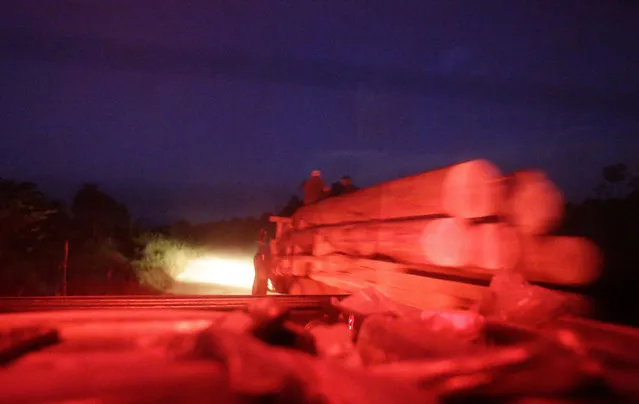
A truck carries logs along a dirt road leading out of the Alto Turiacu Indian territory, as seen from inside a vehicle belonging to the Ka'apor Indian tribe near the Centro do Guilherme municipality in the northeast of Maranhao state in the Amazon basin, August 2, 2014. Tired of what they say is a lack of sufficient government assistance in keeping loggers off their land, the Ka'apor Indians, who along with four other tribes are the legal inhabitants and caretakers of the territory, have sent their warriors out to expel all loggers they find and set up monitoring camps in the areas that are being illegally exploited. (Photo by Lunae Parracho/Reuters)
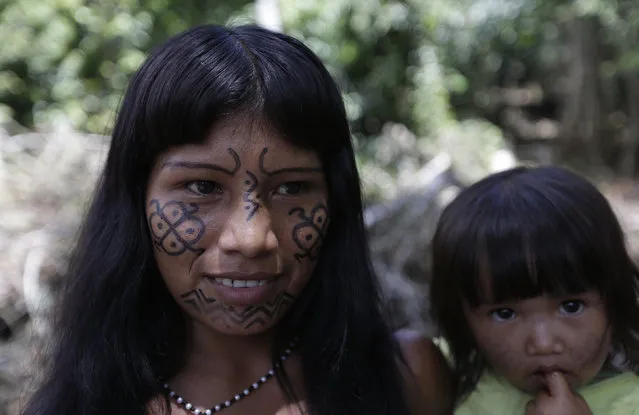
A Ka'apor Indian woman and her daughter in a jungle camp of one of their “protected areas” from where they expelled loggers who they found illegally working in the Alto Turiacu Indian territory, near the Centro do Guilherme municipality in the northeast of Maranhao state in the Amazon basin, August 3, 2014. (Photo by Lunae Parracho/Reuters)
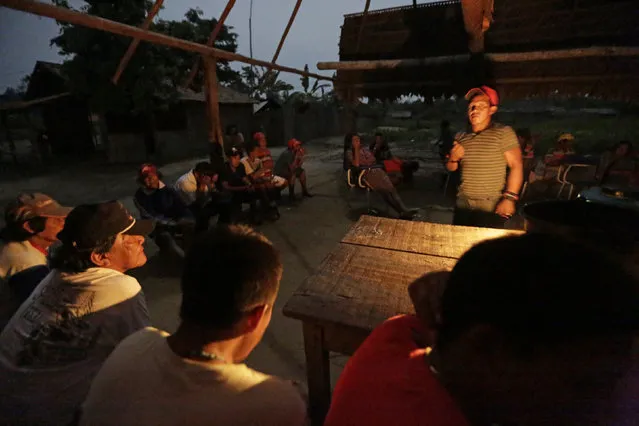
Ka'apor Indian warriors hold a meeting the night before they begin an operation to search for and expel loggers from the Alto Turiacu Indian territory, in the village of Waxiguy Renda near the Centro do Guilherme municipality in the northeast of Maranhao state in the Amazon basin, August 6, 2014. (Photo by Lunae Parracho/Reuters)

Ka'apor Indian warriors hike during a jungle expedition to search for and expel loggers from the Alto Turiacu Indian territory, near the Centro do Guilherme municipality in the northeast of Maranhao state in the Amazon basin, August 7, 2014. (Photo by Lunae Parracho/Reuters)
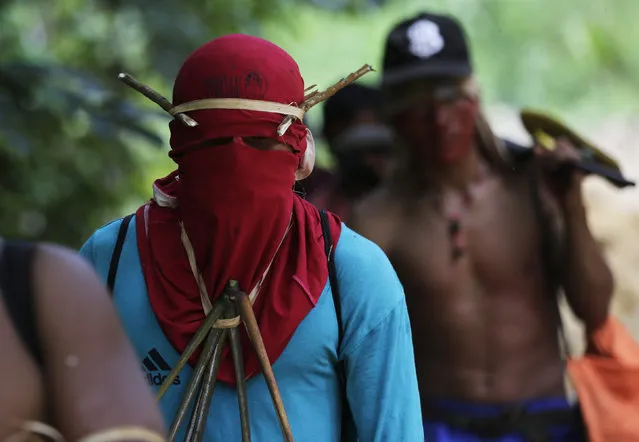
Ka'apor Indian warriors hike during a jungle expedition to search for and expel loggers from the Alto Turiacu Indian territory, near the Centro do Guilherme municipality in the northeast of Maranhao state in the Amazon basin, August 7, 2014. (Photo by Lunae Parracho/Reuters)
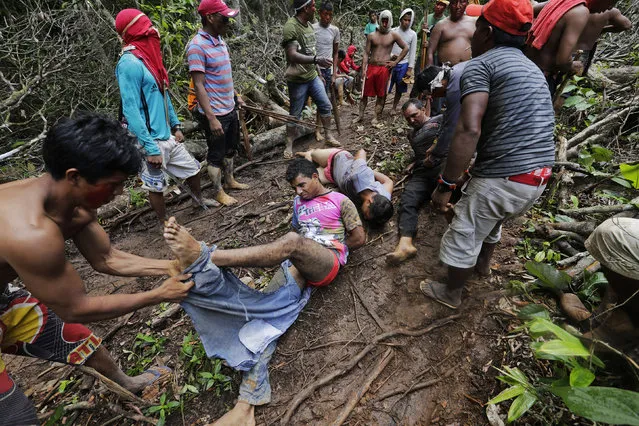
Ka'apor Indian warriors tie up and remove the pants of loggers during a jungle expedition to search for and expel them from the Alto Turiacu Indian territory, near the Centro do Guilherme municipality in the northeast of Maranhao state in the Amazon basin, August 7, 2014. (Photo by Lunae Parracho/Reuters)
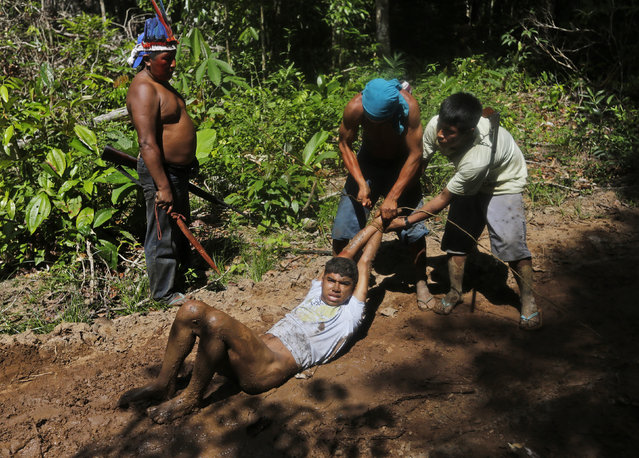
Ka'apor Indian warriors tie up and remove the pants of a logger during a jungle expedition to search for and expel loggers from the Alto Turiacu Indian territory, near the Centro do Guilherme municipality in the northeast of Maranhao state in the Amazon basin, August 7, 2014. (Photo by Lunae Parracho/Reuters)
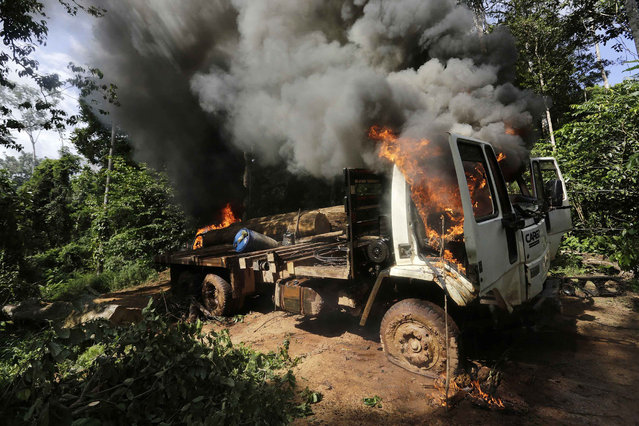
A logging truck burns after it was discovered and set on fire by Ka'apor Indian warriors during a jungle expedition to search for and expel loggers from the Alto Turiacu Indian territory, near the Centro do Guilherme municipality in the northeast of Maranhao state in the Amazon basin, August 7, 2014. (Photo by Lunae Parracho/Reuters)
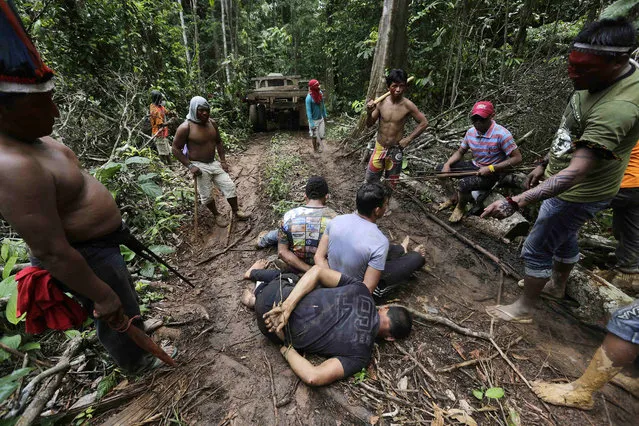
Ka'apor Indian warriors tie up loggers during a jungle expedition to search for and expel them from the Alto Turiacu Indian territory, near the Centro do Guilherme municipality in the northeast of Maranhao state in the Amazon basin, August 7, 2014. (Photo by Lunae Parracho/Reuters)
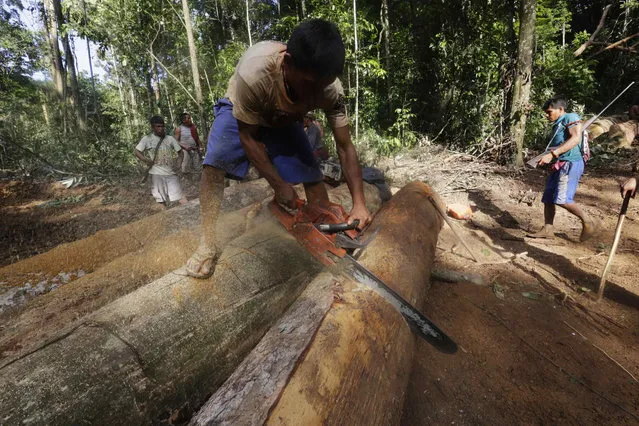
A Ka'apor Indian warrior uses a chainsaw to ruin one of the logs they found during a jungle expedition to search for and expel loggers from the Alto Turiacu Indian territory, near the Centro do Guilherme municipality in the northeast of Maranhao state in the Amazon basin, August 7, 2014. (Photo by Lunae Parracho/Reuters)
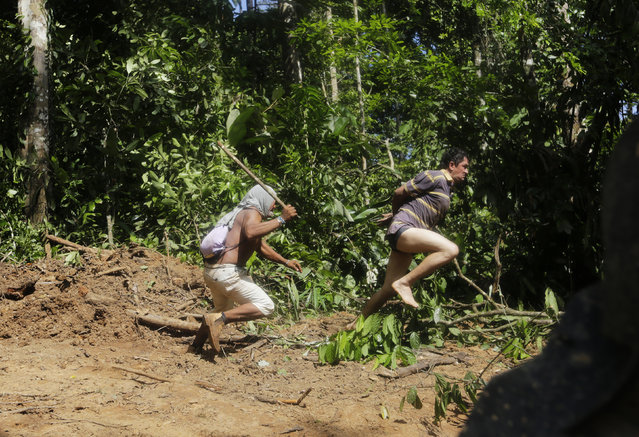
A Ka'apor Indian warrior (L) chases a logger who tried to escape after they captured him during a jungle expedition to search for and expel loggers from the Alto Turiacu Indian territory, near the Centro do Guilherme municipality in the northeast of Maranhao state in the Amazon basin, August 7, 2014. (Photo by Lunae Parracho/Reuters)
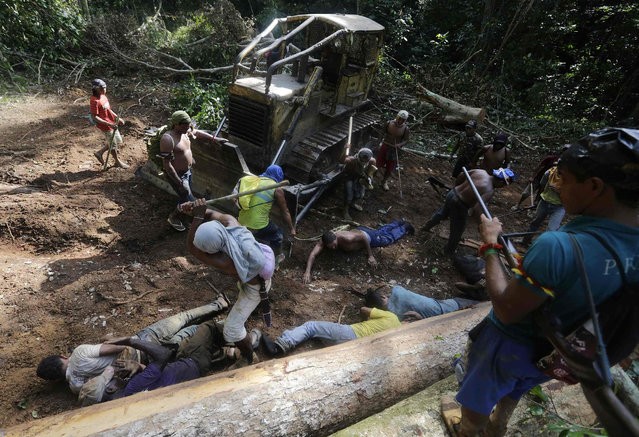
Ka'apor Indian warriors use sticks to hit loggers during a jungle expedition to search for and expel the loggers from the Alto Turiacu Indian territory, near the Centro do Guilherme municipality in the northeast of Maranhao state in the Amazon basin, August 7, 2014. (Photo by Lunae Parracho/Reuters)
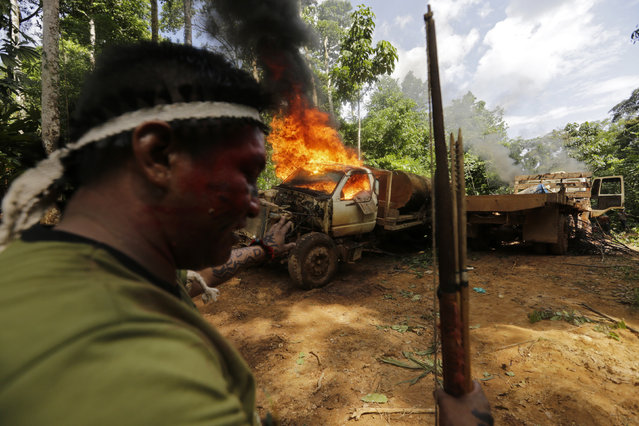
A Ka'apor Indian warrior stands near a logging truck they discovered and set on fire during a jungle expedition to search for and expel loggers from the Alto Turiacu Indian territory, near the Centro do Guilherme municipality in the northeast of Maranhao state in the Amazon basin, August 7, 2014. (Photo by Lunae Parracho/Reuters)
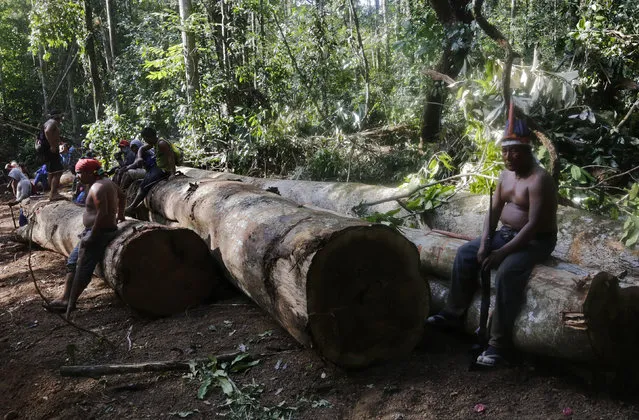
Ka'apor Indian warriors rest on logs they found during a jungle expedition to search for and expel loggers from the Alto Turiacu Indian territory, near the Centro do Guilherme municipality in the northeast of Maranhao state in the Amazon basin, August 7, 2014. (Photo by Lunae Parracho/Reuters)
05 Sep 2014 11:41:00,
post received
0 comments
